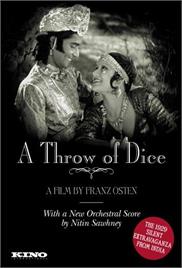Be Careful of Fake Websites. Always use HindiMovies.to domain & Join our Telegram Channel for Latest Updates.

Likes: 8
Views: 1.58K
Two rival kings addicted to gambling, Ranjit (Roy) and the evil Sohan (Rai), also vie for the same woman, Sunita (Seeta Devi), Kanwa the hermit’s (Gupta) daughter. Ranjit loses his kingdom and his love and becomes Sohan’s slave through a crooked game of dice.
Duration: 74 min
Released: 1930
IMDb Rating: 6.8/10 (307 Votes)
Genre: Adventure, Drama, Hindi Movies, Romance
Stars: Himansu Rai, Modhu Bose, Charu Roy, Seeta Devi
Directors: Franz Osten
Writers: Niranjan Pal, W.A. Burton, Max Jungk
Year: 1929
Server 1 – Youtube
Server 2 – Youtube
Server 3 – Youtube
A Throw of Dice (1929): A Mesmerizing Tale of Love, Destiny, and Sacrifice
Introduction
"A Throw of Dice" is a remarkable silent film from 1929 that beautifully combines elements of adventure, drama, romance, and Hindu mythology. Directed by the visionary German filmmaker Franz Osten, this Indian silent epic is considered a classic that captures the grandeur and cultural richness of early Indian cinema. Set against the backdrop of princely rivalries and intertwined love stories, the movie not only explores themes of fate and morality but also offers an insightful visual feast through its stunning cinematography and elaborate sets.
Story and Plot Overview
The narrative is loosely inspired by an ancient episode from the Indian epic, the Mahabharata, narrating a legendary dice game that changes the destiny of kingdoms and individuals alike. The story revolves around two rival princes, Rajah Kumar and Rajah Vikram, who lead their affluent kingdoms into conflict due to pride and jealousy.
Amidst this rivalry, a poignant love story unfolds between a princess named Hemangini and a humble merchant. As fate decrees, their love is put to the ultimate test when the princes engage in a high-stakes game of dice. The dice game symbolizes the capriciousness of fate and human folly. It propels the plot into a dramatic climax, where themes of sacrifice, loyalty, and forgiveness are meticulously explored.
Significantly, the film depiction of characters and their emotional ranges is conveyed powerfully without any spoken dialogue, relying instead on expressive acting, evocative body language, and carefully crafted intertitles.
Main Actors and Their Contributions
Director and Writer
Franz Osten, the German director behind "A Throw of Dice," collaborated extensively with Indian studios during the silent era to produce culturally immersive films. Osten’s vision was instrumental in presenting Indian epics to global audiences with cinematic grandeur and respect for indigenous storytelling.
While the film is an adaptation of Indian legend rather than an original screenplay, the storytelling aligns closely with traditional narrative structures and mythological accounts. The writing credits aren’t attributed to a single individual but rather stem from the collaborative adaptation of Rajput folk tales and Maharaja romances, shaped under Osten’s directorial guidance.
Production and Cinematic Brilliance
Produced under the banner of Bombay Talkies predecessor companies, "A Throw of Dice" is notable for its exquisite art direction and ambitious production scale. The lavish costumes and meticulously constructed sets evoke the splendor of ancient India, transporting viewers to a time of kingdoms, courtesans, and royal intrigue.
The cinematography showcases innovative techniques for its time, capturing large battle scenes and intimate emotional moments with equal finesse. Color tinting applied to some scenes adds to the atmospheric richness.
Significance in Indian Cinema
"A Throw of Dice" is a seminal piece within the canon of Indian silent cinema. Beyond its narrative, the movie represents a crucial bridge in cross-cultural collaboration between British India and German filmmakers. The film contributed to enhancing Indian cinematic storytelling by incorporating Western production values while remaining deeply rooted in Indian culture and mythology.
Moreover, the film stands as a testament to silent cinema’s capacity to convey complex stories purely through visual artistry and shared cultural symbols, establishing foundational aesthetics for future Indian films.
Sound and Music – A Silent Era Feature
Being a silent film, "A Throw of Dice" originally did not include synchronized sound or songs, which were hallmarks of later Bollywood cinema. However, contemporary presentations of the film sometimes feature live musical accompaniment or orchestral scores that reflect Indian classical melodies, enhancing the viewing experience and evoking the intended emotional resonance.
Legacy and Modern Reception
Today, "A Throw of Dice" is cherished by film historians and enthusiasts for its pioneering role in Indian filmmaking. Restored versions have been screened internationally, applauded for both their historical significance and visual splendor.
The film offers modern audiences a unique glimpse into India’s cultural heritage and silent-era storytelling, emphasizing the timeless appeal of tales that delve into human drama, love, and moral dilemmas.
Conclusion
In essence, "A Throw of Dice" (1929) is more than just a movie; it is a beautifully crafted cinematic journey that captures the ethos of an era long past. With evocative performances by Seeta Devi and Himanshu Rai, the visionary direction of Franz Osten, and its profound narrative steeped in Indian mythology, it remains a cornerstone of Indian silent cinema and a treasured classic for film lovers across the world.